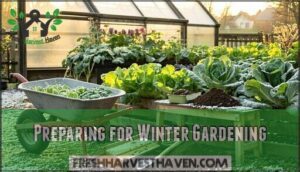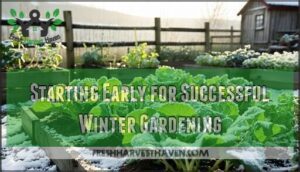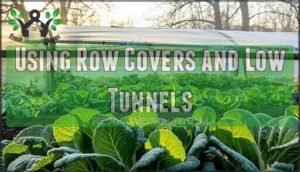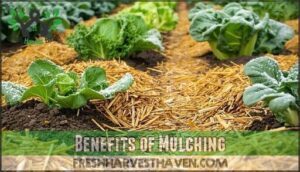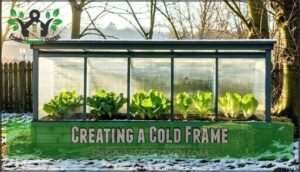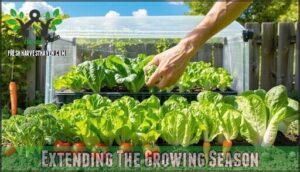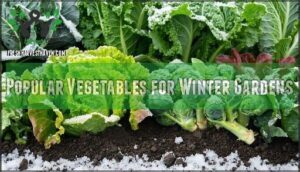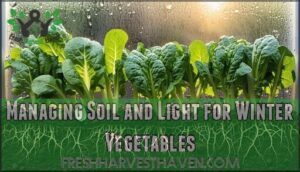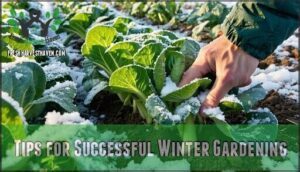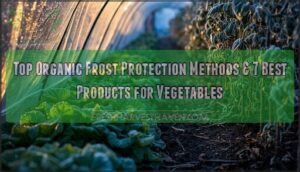This site is supported by our readers. We may earn a commission, at no cost to you, if you purchase through links.
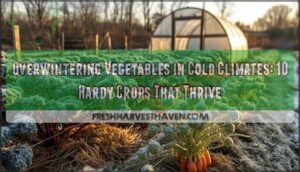
These cold-tolerant crops need proper protection through mulching, row covers, or cold frames to survive harsh winter conditions.
Start planting in late summer or early fall, allowing plants to establish strong root systems before freezing temperatures arrive.
Root vegetables like turnips and parsnips can stay in the ground all winter, while leafy greens benefit from simple protective structures that create warmer microclimates around your plants.
Table Of Contents
- Key Takeaways
- Choosing Cold-Hardy Vegetables
- Preparing for Winter Gardening
- Starting Early for Successful Winter Gardening
- Protecting Plants From Frost
- Growing Vegetables in Unheated Greenhouses
- Overwintering Vegetables in Cold Climates
- Extending The Growing Season
- Popular Vegetables for Winter Gardens
- Managing Soil and Light for Winter Vegetables
- Tips for Successful Winter Gardening
- Frequently Asked Questions (FAQs)
- What is overwintering vegetables?
- Can vegetables grow over winter?
- Does winter mean you have to stop growing vegetables?
- Can vegetables grow in cold weather?
- Which vegetables can survive wet conditions in winter?
- Can vegetables withstand freezing temperatures?
- Which vegetable plants can be overwintered?
- What temperature is too cold for vegetables?
- Can you grow vegetables in an unheated greenhouse in the winter?
- What month do you plant winter vegetables?
- Conclusion
Key Takeaways
- Choose frost-tolerant varieties like kale, Brussels sprouts, and carrots that actually improve in flavor after cold exposure, becoming sweeter as starches convert to sugars.
- Start planting in late summer or early fall to give your vegetables time to establish strong root systems before harsh winter conditions arrive.
- Protect plants with row covers, cold frames, or mulching to create warmer microclimates and shield crops from freeze-thaw cycles that can damage roots.
- Focus on proper soil drainage and preparation since waterlogged conditions during winter can kill overwintering vegetables more easily than cold temperatures alone.
Choosing Cold-Hardy Vegetables
Selecting the right cold-hardy vegetables transforms winter from a dormant season into a productive harvest period.
You’ll want to focus on varieties that both survive freezing temperatures and actually improve in flavor when exposed to frost.
Root Vegetables for Winter Harvest
Root vegetables consistently deliver winter’s most reliable harvest in cold climate gardening.
Winter’s treasure lies buried beneath frost—carrots sweeten, parsnips develop sugar, and turnips transform cold into culinary gold.
These hardy vegetables transform harsh conditions into culinary gold through frost sweetening, where cold converts starches to sugars for enhanced flavor.
Here’s your winter success strategy:
- Harvesting Techniques: Dig carrots, parsnips, and turnips as needed, even beneath snow cover
- Storage Methods: Apply 4+ inches of mulch or straw to insulate overwintering vegetables in-ground
- Variety Selection: Choose cold-hardy cultivars like Purple Top turnips and Nantes carrots for the best winter harvest
Cold-Tolerant Greens for Winter Gardens
Winter greens offer exceptional nutritional benefits and remarkable pest resistance, making them perfect for cold climate gardening.
These hardy vegetables develop enhanced flavor profiles after frost exposure, transforming your winter vegetable garden into a productive sanctuary.
| Vegetable | Temperature Tolerance | Harvesting Methods |
|---|---|---|
| Kale | Down to 20°F (-6°C) | Pick outer leaves continuously |
| Spinach | Survives light freezing | Cut baby leaves regularly |
| Swiss Chard | Hardy with protection | Harvest outer stems first |
| Mache | Exceptional frost tolerance | Cut entire rosettes |
These frost tolerant plants guarantee fresh greens throughout winter’s harshest months, providing a reliable source of winter greens and ensuring a productive sanctuary with enhanced flavor profiles.
Other Cold-Hardy Vegetables
Beyond leafy greens, several coldhardy vegetables expand your winter harvest options. Fava beans withstand harsh conditions while fixing nitrogen in soil. Leeks develop sweeter flavors after frost, making them perfect winter companions to kale and spinach. Winter cress adds peppery bite to salads, while endive and lettuce varieties provide fresh greens throughout cold months.
- Root vegetables: Carrots become sweeter when exposed to freezing temperatures
- Hardy brassicas: Frost tolerant plants like Brussels sprouts improve after cold snaps
- Specialty crops: Winter cress and endive thrive in consistently cool weather
Preparing for Winter Gardening
Success in winter vegetable garden preparation hinges on strategic soil preparation and thoughtful planning.
Before frost dates arrive, you’ll need to tackle these fundamental tasks:
- Test soil pH and enhance drainage using compost or amendments to prevent waterlogged roots during freeze-thaw cycles.
- Evaluate seed inventory and replace outdated packets that won’t germinate reliably in challenging winter conditions.
- Maintain gardening tools by sharpening blades and cleaning equipment for efficient cold-weather work.
- Identify protection methods and mark spots where cold frames, row covers, or other shelter will shield your overwintering vegetables.
Smart plant selection based on your climate zones guarantees your winter garden thrives despite harsh conditions.
Starting Early for Successful Winter Gardening
Timing is everything when you’re planning a successful winter garden.
You’ll need to start your cold-hardy crops well before the first frost hits, giving them enough time to establish strong root systems that can handle whatever winter throws their way, with successful planning being crucial.
Planting Schedules for Different Zones
Once you’ve prepared your winter garden setup, timing becomes your best ally for success. Your USDA Hardiness Zone determines everything about when you’ll plant those cold-hardy varieties.
Zone-Specific Timing varies dramatically across regions. In zones 4-6, you’ll need to plant by late summer since early frosts arrive around October. Zones 7-8 get extra breathing room with frost dates pushing into November. Lucky gardeners in zones 9-10 can plant well into fall.
Microclimate Considerations matter just as much as your official zone. South-facing beds warm faster, extending your planting window by weeks. Urban heat islands push boundaries further.
Regional Planting Guide basics:
Schedule Adjustment Tips: Monitor local weather patterns yearly, as frost dates shift with climate variations. To guarantee proper growth, remember to schedule winter plantings by early summer.
Importance of Soil Temperature
Monitoring soil temperature transforms winter gardening from guesswork into precision agriculture.
Your germination temperatures and root development depend entirely on consistent warmth beneath the surface, making this measurement your most reliable predictor of success.
Use black plastic mulch to capture and retain solar energy, raising soil temperature by 5-10°F compared to bare ground.
Layer organic mulch like straw or shredded leaves around established plants, creating effective root insulation that prevents freeze-thaw cycles.
Invest in a soil thermometer to track daily fluctuations and adjust your soil preparation strategies accordingly.
Winter hardiness isn’t just about air temperature—it’s about creating stable underground conditions.
Mulching vegetables properly maintains the 45-50°F range essential for nutrient uptake and microbial activity.
Your plants’ survival hinges on this foundation.
Protecting Plants From Frost
When winter temperatures threaten your carefully planted vegetables, you’ll need protective strategies that go beyond hoping for mild weather.
Smart frost protection methods like row covers, mulching, and cold frames can mean the difference between a thriving winter harvest and frozen disappointment.
Using Row Covers and Low Tunnels
Two simple structures can transform your winter gardening success. Row covers and low tunnels create protective microclimates that boost temperatures by 4-5°F, extending your harvest season by 6-8 weeks beyond typical outdoor conditions.
Row Cover Material should be lightweight spunbonded fabric allowing 80% light transmission while blocking wind and pests. For Installation Methods, space fiberglass or PVC hoops every 4-5 feet, securing covers with rocks or boards every 2 feet.
Cost Effectiveness shines through season-long protection at fraction of greenhouse expenses. Tunnel Ventilation becomes critical when day length exceeds 10 hours—remove covers between 9 AM and 3 PM to prevent overheating.
These protective structures excel at Pest Control, creating physical barriers against cabbage butterflies and leafminers while maintaining ideal growing conditions for your cold frame gardening setup. **Low tunnels help with frost damage prevention during the colder months.
- Temperature regulation: Multiple cover layers protect crops down to 14°F
- Pest barrier: Fine mesh excludes even small insects like aphids
- Weather shield: Guards against hail, wind, and heavy rainfall damage
Benefits of Mulching
Mulching creates a protective blanket that transforms your winter garden’s soil conditions.
Apply organic mulch like straw or shredded leaves around plants for temperature regulation and moisture retention.
This soil management strategy provides weed suppression while enriching earth through decomposition.
You can easily find various types for your garden.
The insulation effect maintains consistent soil temperature, protecting roots from freeze-thaw cycles.
Mulching also offers pest control benefits by creating barriers against harmful insects during dormant seasons.
Creating a Cold Frame
While mulching provides excellent ground-level protection, cold frames create a controlled environment that takes your winter garden to the next level.
These simple structures use Frame Materials like old windows or clear polycarbonate panels mounted on wooden sides. Location Selection matters—choose a sunny, south-facing spot protected from harsh winds.
Insulation Methods include adding straw bales around the frame’s exterior or lining walls with bubble wrap. Many gardeners opt for pre-fabricated cold frames for easy setup.
Address Ventilation Needs by propping open the lid on warm days to prevent overheating. Watering Strategies require careful monitoring since the enclosed space retains moisture longer than open beds.
- Watch seedlings emerge despite freezing temperatures outside
- Harvest fresh greens when neighbors’ gardens lie dormant
- Feel the warmth radiating from sun-heated soil on cold days
- Enjoy crisp lettuce picked minutes before dinner
- Experience the satisfaction of year-round homegrown vegetables
Growing Vegetables in Unheated Greenhouses
Unheated greenhouses create microclimates that protect cold hardy varieties from harsh winter conditions while extending your growing season.
These structures typically maintain temperatures 10-15°F warmer than outside, making hoop house gardening viable even in freezing climates.
Proper greenhouse ventilation prevents humidity buildup that causes fungal diseases, while strategic placement maximizes solar heat gain.
Choose durable greenhouse materials like polycarbonate for insulation.
Water conservation becomes essential—water less frequently but deeply, allowing soil to dry between irrigations.
With effective pest management and temperature monitoring, your unheated greenhouse becomes a productive winter garden sanctuary.
Overwintering Vegetables in Cold Climates
Successfully growing winter vegetables in cold climates requires choosing varieties specifically bred for frost tolerance and cold resistance.
You’ll need to provide adequate light through strategic positioning and maintain proper soil drainage while maintaining consistent moisture levels throughout the dormant season, which is crucial for cold resistance.
Selecting The Right Varieties
Why let winter limit your vegetable garden’s potential? Successful overwintering vegetables start with selecting the right coldhardy varieties suited to your Climate Considerations. Begin by identifying your Hardiness Zones – this determines which hardy vegetables can survive your local conditions.
Choose proven performers like ‘Red Russian’ kale, which tolerates temperatures down to 5°F, or ‘Winterbor’ kale for exceptional toughness. Local Nurseries often stock regionally-adapted varieties that perform better than generic options in cold climate gardening.
Prioritize vegetable varieties cold-bred for shorter growing seasons and enhanced Disease Resistance. Many coldhardy varieties like parsnips and Brussels sprouts develop superior Flavor Profiles after frost exposure, converting starches to sugars.
Check seed packets for specific temperature tolerances and days to maturity. Varieties like ‘Winter Density’ lettuce survive 15°F, while ‘Vates’ collards handle even harsher conditions.
Providing Adequate Light and Soil Conditions
Beneath winter’s harsh surface, your soil conditions and light management determine whether your hardy vegetables merely survive or truly thrive.
Essential Elements for Winter Growing Success:
- Soil pH maintenance between 6.0-7.0 guarantees the best nutrient uptake for cold-hardy crops
- Drainage Solutions prevent waterlogged roots that freeze and rot during harsh weather cycles
- Nutrient Balance through compost additions provides sustained energy for slow winter growth
- Light Spectrum positioning in your garden’s sunniest spots maximizes precious daylight hours
- Winter Watering techniques that avoid ice formation while maintaining soil health
Quality soil preparation involves testing drainage by digging test holes and amending heavy clay with organic matter. Soil quality directly impacts root development, while proper soil drainage prevents the soggy conditions that kill overwintering plants.
To further protect plants, consider using row covers for protection. Monitor soil preparation carefully—your vegetables depend on these foundations for survival through freezing months ahead.
Extending The Growing Season
You can stretch your garden’s productivity well beyond the traditional growing season by combining strategic timing with protective techniques.
Smart use of shade cloth during late summer heat, heavy mulching for root insulation, and carefully timed plantings in early spring and late fall will keep fresh vegetables coming to your table.
Even when snow covers the ground, these methods will provide a continuous harvest, ensuring that you have access to fresh produce throughout the year.
Utilizing Shade Cloth and Mulching
Smart shade cloth types and strategic mulching create the perfect winter survival kit for your overwintering vegetables.
Winter shade cloth blocks harsh winds and moderates temperature swings, while different shade cloth types offer varying protection levels.
Reflective mulch bounces light upward, warming plants naturally. Mulch depth effects matter—four inches of organic material insulates roots and maintains stable soil temperature.
Unlike summer mulching, winter applications focus on protection rather than cooling. These methods are examples of season extension strategies.
This cold climate gardening combo shields plants from freeze-thaw cycles, locks in moisture, and suppresses weeds, giving your hardy crops the armor they need.
Planting Early Spring and Late Fall
Strategic timing transforms winter gardening from survival mode to abundance. You’ll maximize cold climate gardening success by mastering spring planting and fall planting windows that work with nature’s rhythm instead of against it.
Key timing strategies for extending growing season:
- Spring planting: Start cold-hardy varieties like spinach and arugula 2-4 weeks before last frost when soil reaches 40°F
- Fall planting: Sow overwintering vegetables 10-12 weeks before first hard freeze for proper root establishment
- Variety selection: Choose quick-maturing cultivars that can handle temperature swings
- Soil preparation: Warm beds with black plastic or compost to jump-start growth
Considerations for Overwintering
Winter garden planning starts with understanding your environment and making informed decisions about plant selection and timing.
Your climate considerations determine which hardy vegetables can survive outdoors without protection.
Frost dates guide when to implement protection methods like row covers, cold frames, or mulching.
Soil preparation becomes more critical in winter, requiring excellent drainage and organic matter to prevent root rot and provide insulation.
Success with overwintering vegetables in cold climates requires matching varieties to your zone’s specific conditions and establishing plants before winter’s harsh grip takes hold.
Popular Vegetables for Winter Gardens
You’ll find several hardy vegetables that thrive as well as survive in winter’s harsh conditions, transforming your garden from a seasonal space into a year-round source of fresh produce.
These cold-weather champions develop sweeter flavors after frost exposure and provide continuous harvests when other crops have long since finished.
Mache (Corn Salad)
Mache stands out among cold hardy winter vegetables for its exceptional frost tolerance and nutritional value.
This overwintering vegetable survives temperatures down to 5°F, making it perfect for cold weather crops. Mache varieties like ‘Vit’ and ‘Green Heart’ offer superior mache nutrition with vitamins A and C.
Growing mache requires well-draining soil and fall seeding. Mache pests rarely trouble this hardy green.
Harvest outer leaves continuously throughout winter, leaving centers intact for regrowth.
Its mild, nutty flavor enhances mache recipes from simple salads to gourmet dishes, providing fresh greens when other winter vegetables struggle.
Radicchio
Radicchio adds vibrant color and distinctive bitter flavor to winter gardens, making it perfect for overwintering vegetables in cold climates. These cold hardy winter vegetables develop sweeter notes after frost exposure, transforming their characteristic bite into complex flavors.
Here are four key radicchio varieties for winter success:
- ‘Indigo’ – Produces deep purple heads with exceptional cold tolerance
- ‘Leonardo’ – Compact variety perfect for successive plantings throughout winter
- ‘Pacifico’ – Large, colorful heads that withstand repeated frost cycles
- ‘Chioggia’ – Traditional round variety with striking red-white striped leaves
Winter care involves protecting plants with row covers during extreme cold snaps. Harvesting tips include cutting entire heads when firm and colorful, typically 70-85 days after planting. Culinary uses range from fresh winter salads to grilled preparations that caramelize the natural sugars developed through cold exposure.
Collard Greens
Collard greens stand as powerhouse overwintering vegetables that laugh at winter’s bite. These hardy vegetables flourish in cold climates, making them perfect stars for your winter vegetable garden.
Collard varieties like ‘Georgia Southern’ and ‘Champion’ offer incredible nutritional benefits, packing vitamins A, C, and K into every leaf.
Here’s your roadmap to collard greens success:
- Choose cold-hardy collard varieties suited for your zone
- Plant in well-draining, fertile soil with proper spacing
- Implement companion planting with onions for natural pest control
- Harvest outer leaves continuously to encourage new growth
- Apply mulch protection during severe cold snaps
These versatile greens improve after frost exposure, developing sweeter flavors that make them Southern cooking favorites. With proper care, you’ll enjoy fresh harvests throughout winter.
Mustard Greens
Mustard greens pack a peppery punch that intensifies winter gardens.
These hardy vegetables tolerate frost better than most cold climates crops, with mustard varieties like ‘Red Giant’ and ‘Green Wave’ offering distinct flavor profiles.
Their pest resistance and nutritional benefits make them ideal overwintering vegetables.
Sow in late summer for continuous harvest, enjoying their culinary uses in stir-fries and salads throughout winter.
Arugula
Arugula’s peppery bite transforms any winter vegetable garden into a flavorful haven. This resilient green thrives in cold climates, making it perfect for overwintering vegetables.
Winter sowing extends your harvest through frost, while proper companion planting boosts pest resistance.
- Plant arugula varieties like ‘Astro’ in late summer for continuous harvest
- Use row covers during harsh weather to protect tender leaves
- Harvest outer leaves regularly to encourage new growth
- Practice companion planting with radishes to deter flea beetles
- Store fresh leaves in damp paper towels for maximum flavor profiles
Managing Soil and Light for Winter Vegetables
Managing winter vegetables successfully means getting two critical factors right from the start.
Your soil needs excellent drainage and steady fertility, while your plants require enough light to maintain growth during shortened winter days.
Soil Conditions for Optimal Growth
Most successful winter gardens start with soil that drains properly, preventing waterlogged roots during freeze-thaw cycles. Soil drainage becomes critical when snow melts create standing water around vulnerable plants.
Your soil pH should hover between 6.0 and 7.0 for ideal nutrient uptake. Test it before winter arrives, then adjust with lime or sulfur as needed.
Soil nutrients matter too—enrich beds with aged compost types like leaf mold or well-rotted manure in fall. Winter mulch helps regulate soil temperature fluctuations that can damage roots.
Apply three to four inches of straw or shredded leaves around plants. Well-prepared soil conditions create the foundation your cold-hardy vegetables need to survive harsh weather and emerge strong come spring.
You can also improve your chances of success by assessing climate and soil.
Light Requirements for Different Vegetables
Different overwintering vegetables have varying light needs that affect their winter garden performance.
Most cold-hardy greens like spinach, kale, and mache tolerate just 4-6 hours of daily sunlight, while root vegetables such as carrots and beets perform better with 6-8 hours.
Light spectrum and photoperiod effects become critical when natural light duration drops below 10 hours, triggering plant dormancy.
- Low-light champions: Leafy greens thrive with minimal sunlight and partial shade conditions.
- Moderate needs: Root crops require consistent 6+ hours for proper development and sugar accumulation.
- Artificial lighting: LED grow lights provide necessary intensity needs when winter daylight fails your garden.
Tips for Successful Winter Gardening
You’ll maximize your winter garden’s success by staying on top of regular harvesting and careful monitoring throughout the cold months.
Consistent attention to frost tolerance levels and soil temperature changes guarantees your hardy crops continue thriving even when temperatures drop below freezing, which is crucial for the garden’s success.
Regular Harvesting and Maintenance
The key to winter gardening success lies in maintaining regular harvesting schedules and consistent garden care.
You’ll want to harvest leafy greens and root vegetables weekly to encourage continued growth and prevent disease buildup.
During your regular visits, check for signs of pest damage and remove any debris that could harbor harmful insects.
Winter garden maintenance requires attention to watering needs, guaranteeing soil stays moist but not waterlogged.
Snow removal from protective structures keeps plants accessible, while proper pruning techniques involve removing damaged or yellowing leaves to maintain plant health.
To guarantee freshness, consider optimal storage environments for harvested produce.
| Task | Frequency | Focus Area |
|---|---|---|
| Regular harvesting | Weekly | Stimulate growth, prevent disease |
| Pest control | Bi-weekly | Check for damage, remove debris |
| Crop rotation | Seasonally | Preserve soil nutrients, prevent depletion |
Effective overwintering strategies include light composting between harvests and implementing crop rotation to maintain soil balance.
These winter protection methods guarantee your hardy vegetables continue thriving through the coldest months while setting up your garden for spring success.
Monitoring Frost Tolerance and Soil Temperature
Staying on top of frost tolerance levels and soil temperature impacts keeps your winter garden thriving when temperatures plummet.
Smart temperature monitoring tools help you make precise cold weather adjustments for successful microclimate management.
Track these essential metrics for your overwintering vegetables:
- Soil temperature at 2-4 inch depths using digital thermometers—most hardy crops need soil above 32°F for root function
- Frost tolerance thresholds for each crop (kale survives 20°F, while lettuce needs protection at 28°F)
- Microclimate variations across your winter garden using wireless sensors that alert you before damaging freezes
Understanding these temperature patterns in cold climates lets you deploy row covers strategically and harvest at ideal times, turning winter gardening from guesswork into science.
Frequently Asked Questions (FAQs)
What is overwintering vegetables?
Overwintering vegetables means you’re growing cold-hardy crops through winter months, letting them survive freezing temperatures to provide fresh produce when most gardens lie dormant.
Can vegetables grow over winter?
Yes, you can successfully grow vegetables throughout winter using cold-hardy varieties like kale, spinach, carrots, and garlic.
These tough plants actually develop sweeter flavors after frost exposure, giving you fresh produce all season long.
Does winter mean you have to stop growing vegetables?
Winter doesn’t stop vegetable growing—it transforms it.
You’ll discover cold-hardy crops like kale, carrots, and Brussels sprouts actually thrive in freezing temperatures, becoming sweeter after frost exposure while providing fresh harvests.
Can vegetables grow in cold weather?
Think cold weather kills your garden dreams? You’re wrong! Many vegetables thrive in freezing temperatures, becoming sweeter as frost converts starches to sugars, giving you fresh harvests all winter long.
Which vegetables can survive wet conditions in winter?
Several vegetables thrive in wet winter conditions, including kale, spinach, leeks, and Brussels sprouts. Root vegetables like carrots and parsnips handle moisture well with proper drainage and mulching protection.
Can vegetables withstand freezing temperatures?
Like nature’s hardy survivors pushing through winter’s icy grip, many vegetables can withstand freezing temperatures.
You’ll find kale, Brussels sprouts, carrots, and spinach actually become sweeter after frost, transforming cold into culinary gold.
Which vegetable plants can be overwintered?
You can overwinter hardy vegetables like kale, spinach, Brussels sprouts, carrots, garlic, leeks, and parsnips. These cold-tolerant crops survive freezing temperatures and often develop sweeter flavors after frost exposure.
What temperature is too cold for vegetables?
Most vegetables can’t survive temperatures below 20°F (-6°C), though hardy varieties like kale, Brussels sprouts, and root vegetables tolerate freezing better with proper protection and mulching.
Can you grow vegetables in an unheated greenhouse in the winter?
Yes, you can grow vegetables in an unheated greenhouse during winter. Cold-hardy crops like kale, spinach, and carrots thrive with the greenhouse’s protection from wind and extreme temperatures.
What month do you plant winter vegetables?
Timing your winter garden isn’t rocket science, but getting it right makes all the difference.
You’ll plant most winter vegetables in late summer through early fall, typically August through October, depending on your specific crop and climate zone.
Conclusion
Despite winter’s harsh reputation, successful overwintering vegetables in cold climates isn’t impossible when you’re prepared.
You’ll enjoy fresh harvests through cold months by selecting hardy varieties and implementing proper protection methods.
These resilient crops actually develop better flavor after frost exposure, making winter gardening rewarding.
With adequate mulching, row covers, and timing, you’ll maintain productive gardens year-round.
Start your cold-weather growing adventure this fall and discover how overwintering vegetables in cold climates transforms your seasonal eating habits.
- https://go.redirectingat.com/?id=92X1623321&xcust=homesandgardens_us_6449006664342802726&xs=1&url=https%3A%2F%2Fnaturehills.com%2Fcollections%2Fgarlic&sref=https%3A%2F%2Fwww.homesandgardens.com%2Fgardens%2Fbest-vegetables-to-overwinter
- https://homeplaceearth.wordpress.com/2014/12/09/building-low-tunnels-and-securing-the-covers/
- https://sonomamg.ucanr.edu/Food_Gardening/Feature_Vegetables/Mache/
- https://en.wikipedia.org/wiki/Endive
- https://ag.purdue.edu/department/btny/ppdl/potw-dept-folder/2022/daikon-radish.html

